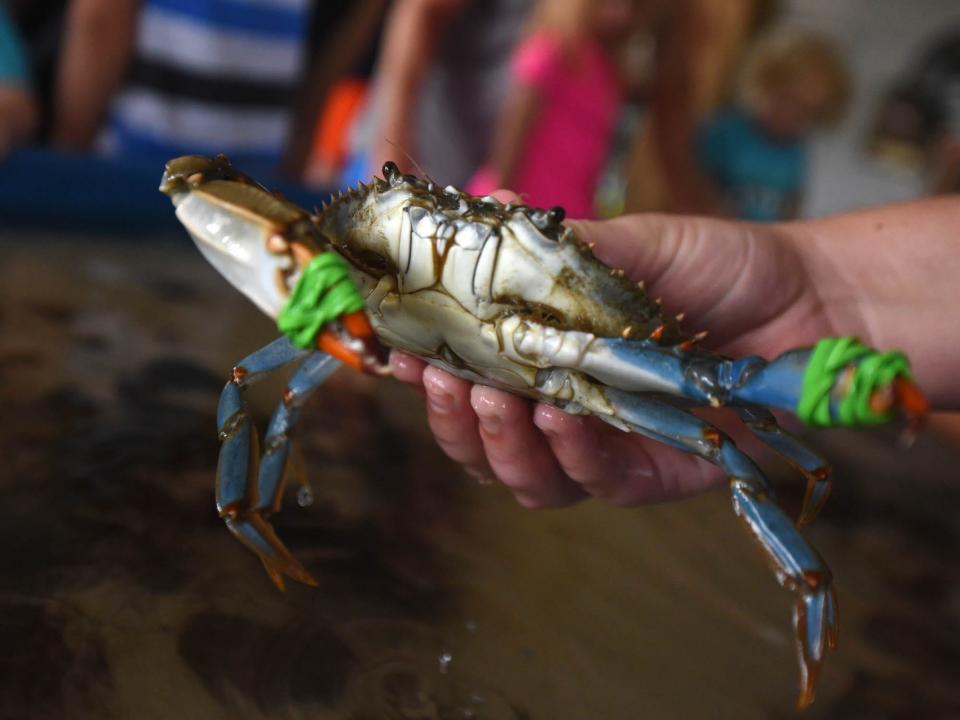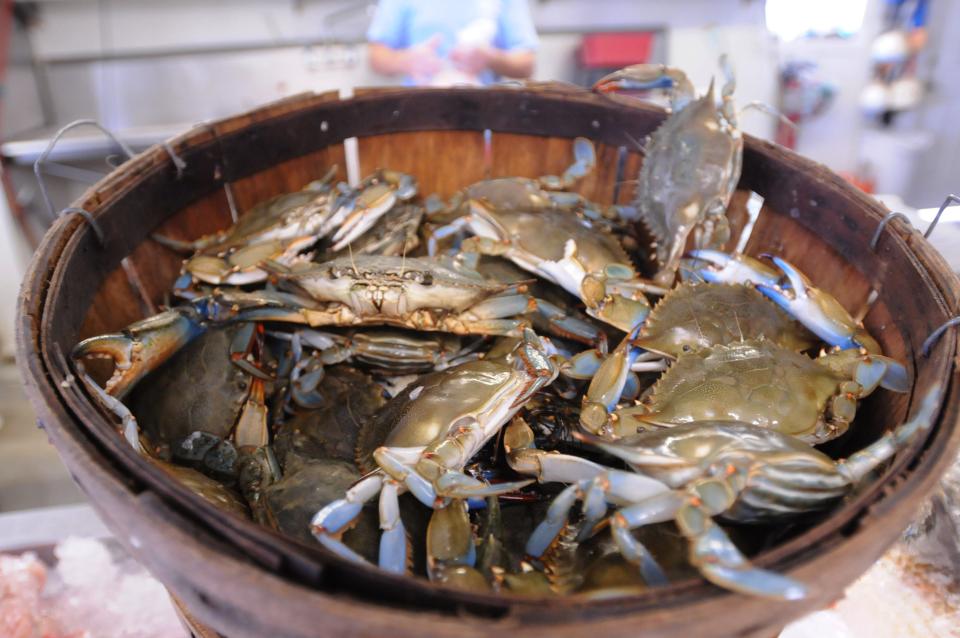NC's blue crab numbers have been dropping for years, and the possible reasons why are many
They are an iconic sight and calling card for the North Carolina coast, popular with children to try and catch and adults to eat.
But like the state's oysters and flounder fisheries, blue crabs in the Tar Heel State have seen better days.
Crab numbers harvested in recent years have fallen precipitously, and there's no smoking gun as to why − although there are probably plenty of factors at play.
Dr. Dan Rittschof has been at the Duke University Marine Lab for more than 40 years.
"I've watched it crash, and it hasn't come back," said the marine ecologist of North Carolina's blue crab fishery. "What the cause? I would offer there are a lot of causes."
Like the seafood industry as a whole, officials say there are likely a number of factors contributing to the decline, including overfishing and habitat loss. Tighter health and safety regulations, rising costs, and overseas competition that has contributed to a dramatic decline in the onshore fishing infrastructure, like crab houses to process fishermen's catch, not to mention a shortage of labor also has played a role.
But Rittschof said while there's a lot of debate as to how much of a role one particular factor might be, there's one cause that is almost universally accepted.
"Declining water quality is one of the few things everyone can agree on," he said, ticking off runoff from inland agricultural sources and rampant development along the coast that sends streams of polluted stormwater into sensitive waters as the primary culprits. "I don't think you can overstate the impact people pressure is having on the system."
Climate change also could be adding pressures to coastal ecosystems, and to the habitats crabs and other marine life rely on. A report on South Carolina's struggling blue crab fishery, published by the S.C. Department of Natural Resources earlier this year, found blue crab population declines could be due to the state's estuaries getting warmer and saltier.
MORE North Carolina could loosen protections for isolated, 'dry' wetlands under new farm bill
Changing protections
With no quick, easy, simple or cheap fix readily available, declining water quality is a problem that will require a comprehensive, multi-faceted plan involving many players to reverse. But environmentalists and others worry the situation could get worse before it gets better because of recent actions in Washington and Raleigh to water down the protections offered for isolated wetlands and ephemeral ponds and wetlands that aren't wet all of the time, like pocosins.
In May the U.S. Supreme Court ruled that wetlands that don't have a surface connection to another body of water that has federal protection shouldn't themselves receive federal protection. Previously, regulators had been allowed to take a broader view that said waters can be connected in many ways, including underground. The GOP-dominated N.C. General Assembly this summer passed legislation, over a veto by Democratic Gov. Roy Cooper, that the state rules must mirror the federal one.
Environmentalists and clean water advocates claim sacrificing the wetlands that are cut off from other bodies of water that have federal protection under the Clean Water Act would increase flooding − already a major problem in Eastern North Carolina − and damage water quality, since wetlands absorb contaminants as water slowly passes through them or is absorbed into the ground. Supporters of the change say isolated wetlands have been overregulated for years, will give more freedom to property owners to develop their land, and that the rule won't strip protections from the vast majority of North Carolina's wetlands.
According to the Southern Environmental Law Center, the regulatory change places an estimated 527,000 acres of wetlands in the Cape Fear River watershed, and millions of acres across the state, at risk.

A struggling fishery, but not everywhere
Blue crabs have historically played a vital economic role in sustaining the state's fishermen and fishing communities.
According to the latest update to the blue crab management plan by the N.C. Division of Marine Fisheries, the state has historically accounted for approximately 22% of annual Atlantic coast blue crab landings since 1950. Landings of blue crab in North Carolina have fluctuated through time but peaked in the late 1990s. In 1996, for example, fishermen caught 65.7 million pounds of blue crab valued at nearly $40 million.
But since then, landings have fallen precipitously. Average blue crab landings in North Carolina between 2007 and 2016 were still a healthy 27.8 million pounds. The lowest landings during this period was 21.4 million pounds in 2007 and the highest was 32.9 million pounds in 2008, according to fisheries statistics.
But lately, landings aren't coming close to these numbers. In 2022, landings reached an all-time low of 9.53 million pounds − although the Covid-19 pandemic could have played a role in keeping crabbers in port and limiting demand. That follows a catch of 12 million pounds in 2021 and 13.1 million in 2020. As most recently as 2015, that number was 31 million pounds, according to marine fisheries.
State regulators have determined that North Carolina's blue crabs are overfished even as it remains the state's most valuable fishery.
The Tar Heel State isn't alone amid Mid-Atlantic and Southeastern states that have struggling crab fisheries. But not all coastal states have declining crab populations. Along the Gulf Coast, blue crab fisheries are booming. According to the Louisiana Department of Wildlife and Fisheries, commercial landings of blue crab in Louisiana have generally remained above 40 million pounds per year since 1997, reaching 55 million pounds in 2009. Many of those crabs end up in restaurants and fish markets in Maryland, where crabs are prized even as that state's crab fishery struggles.
'Under gradual, continuous stress'
According to the state's management plan, blue crabs have been shown to be more abundant in beds of submerged aquatic vegetation than in shallow unvegetated estuarine bottoms. Within those grass beds, juvenile crab density was documented to be greater where the beds are large, continuous, and vegetated with dense, tall grass shoots.
Dr. Martin Posey, a marine biologist at the University of North Carolina Wilmington, said the seagrass beds along with oyster reefs play a critical role in acting as habitat for juvenile crabs.
"But all of that is under gradual, continuous stress and is declining throughout the Southeast," he said.
HELPING HAND Living shorelines: Along the N.C. coast, preparing for rising waters with natural remedies
As those habitats suffer, especially along their edges, there are fewer young crabs to sustain the adult population − and the fishery as a whole, he added. Efforts to protect and increase habitats, such as by creating protected sanctuaries, manmade oyster reefs and living shorelines, also are welcome but can only have a limited impact on reversing the trend.
Rittschof said the initial steps to protect marine habitats and fisheries in general often focused on regulating fishing activities, like limiting when fishermen could work, how much they could catch, and what type of equipment they could use. But on land, moves were much less coordinated or focused even as coastal populations boomed.
"We never thought to protect sounds and marshes or what was ending up in them, so there's been enormous habitat loss," the Duke researcher said.
The state's fishery management plans are reviewed every five years, giving regulators the chance to tweak them and makes changes if a fishery isn't showing signs of recovering. An updated assessment of the blue crab fishery is now underway, and marine fisheries staff will use the findings to determine if any changes to how the fishery is managed are needed to help sustain or improve recovery efforts. Those findings will then be presented to the N.C. Marine Fisheries Commission for its review.
Will any proposed changes help the state's struggling crab population?

They certainly can't hurt, Rittschof and Posey said. But with the source of the problem so large and involving so many different impacts from so many different sources, the true impact of any changes might be limited.
One hopeful idea that's often mentioned is that the steady decline in crab numbers is just part of a natural ebb and flow, and the fishery will eventually bounce back.
But Rittschof said the Chesapeake Bay's crab fishery crashed decades ago, and it still hasn't bounced back. A 2022 survey by the Chesapeake Bay Foundation showed the overall crab population dropped for the third consecutive year to its lowest level in the survey’s 33-year history. It also showed a continuing low number of juvenile crabs.
"I don’t know of any evidence that the crabs are undergoing any cyclical cycles," Posey said.
Reporter Gareth McGrath can be reached at GMcGrath@Gannett.com or @GarethMcGrathSN on Twitter. This story was produced with financial support from 1Earth Fund and the Prentice Foundation. The USA TODAY Network maintains full editorial control of the work.
This article originally appeared on Wilmington StarNews: Blue crab numbers falling in NC. Causes are many. Solutions few.

